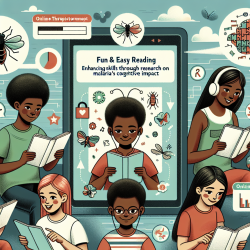Introduction
In the realm of early childhood development, making informed, data-driven decisions is crucial for fostering positive health outcomes. A recent narrative review titled "Health Outcomes in Children Associated with Prenatal and Early-Life Exposures to Air Pollution" sheds light on the profound impact of air pollution on children's health. This blog explores the findings of the review and provides actionable insights for practitioners aiming to improve their skills and outcomes for children.
The Impact of Air Pollution on Early Childhood Development
The review highlights the significant role of prenatal and early-life exposure to air pollutants in shaping children's health outcomes. The research synthesizes evidence from various studies, emphasizing the association between air pollution and adverse cardiovascular, metabolic, respiratory, allergic, and neurodevelopmental outcomes in children.
Key findings include:
- Exposure to particulate matter (PM2.5 and PM10), nitrogen dioxide (NO2), and ozone (O3) during prenatal and early childhood periods is linked to low birth weight, preterm birth, and increased risk of metabolic disorders.
- Respiratory issues, such as asthma and decreased lung function, are associated with early exposure to ambient and traffic-related air pollutants.
- Neurodevelopmental challenges, including cognitive and behavioral deficits, have been observed in children exposed to air pollution during critical developmental windows.
Actionable Insights for Practitioners
For practitioners in speech-language pathology and related fields, understanding the implications of these findings is essential for optimizing intervention strategies and promoting healthier developmental trajectories for children.
1. Embrace Data-Driven Decision Making
Utilize data from research studies to inform clinical practices and intervention plans. By integrating evidence-based insights into your approach, you can tailor interventions to address specific health outcomes associated with air pollution exposure.
2. Advocate for Environmental Health Awareness
Educate parents, caregivers, and communities about the impact of air pollution on children's health. Encourage proactive measures to reduce exposure, such as advocating for cleaner air policies and promoting indoor air quality improvements.
3. Collaborate with Multidisciplinary Teams
Collaborate with healthcare professionals, environmental scientists, and policymakers to develop comprehensive strategies that address the root causes of air pollution and its effects on child health. Interdisciplinary collaboration can lead to more effective interventions and policy changes.
4. Engage in Continuous Research
Stay informed about the latest research developments in the field of air pollution and child health. Encourage further studies to identify critical exposure periods, detrimental pollutants, and effective intervention strategies.
Conclusion
As practitioners dedicated to improving children's health outcomes, leveraging data-driven insights from research on air pollution exposure is vital. By integrating these findings into clinical practices, advocating for environmental health, collaborating with multidisciplinary teams, and engaging in continuous research, we can create a healthier future for children.
To read the original research paper, please follow this link: Health Outcomes in Children Associated with Prenatal and Early-Life Exposures to Air Pollution: A Narrative Review.










